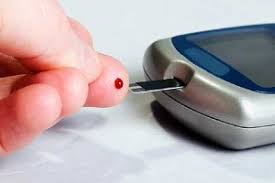- Home
- Editorial
- News
- Practice Guidelines
- Anesthesiology Guidelines
- Cancer Guidelines
- Cardiac Sciences Guidelines
- Critical Care Guidelines
- Dentistry Guidelines
- Dermatology Guidelines
- Diabetes and Endo Guidelines
- Diagnostics Guidelines
- ENT Guidelines
- Featured Practice Guidelines
- Gastroenterology Guidelines
- Geriatrics Guidelines
- Medicine Guidelines
- Nephrology Guidelines
- Neurosciences Guidelines
- Obs and Gynae Guidelines
- Ophthalmology Guidelines
- Orthopaedics Guidelines
- Paediatrics Guidelines
- Psychiatry Guidelines
- Pulmonology Guidelines
- Radiology Guidelines
- Surgery Guidelines
- Urology Guidelines
Non-invasive patch - a low cost glucose test alternative

Currently, there is no available needle-free approach for diabetics to monitor glucose levels in the interstitial fluid.The researchers at University of Bath have developed an adhesive patch that measures glucose through the skin for better Diabetes management.It is a path-selective, non-invasive, transdermal glucose monitoring system based on a miniaturized pixel array platform (realized either by graphene-based thin-film technology, or screen-printing).The full review of the patch has been published in Journal Nature Nanotechnology.
The monitor developed at Bath promises a truly calibration-free approach, an essential contribution in the fight to combat the ever-increasing global incidence of diabetes."The system samples glucose from the interstitial fluid via electroosmotic extraction through individual, privileged, follicular pathways in the skin, accessible via the pixels of the array. A proof of principle using mammalian skin ex vivo is demonstrated for specific and ‘quantized’ glucose extraction/detection via follicular pathways, and across the hypo- to hyper-glycaemic range in humans.
Furthermore, the quantification of follicular and non-follicular glucose extraction fluxes is clearly shown. In vivo continuous monitoring of interstitial fluid-borne glucose with the pixel array was able to track blood sugar in healthy human subjects. This approach paves the way to clinically relevant glucose detection in diabetics without the need for invasive, finger-stick blood sampling.
A number of non-invasive glucose patches are being worked on worldwide in a bid to remove the ‘finger pricking’ aspect of blood glucose testing, and the researchers hope their design could eventually become a low-cost, wearable device for people with diabetes.The patch works by accessing glucose from fluid between cells across hair follicles, without piercing the skin. These follicles are accessed using small sensors and an electric current.Glucose readings can be taken every 10-15 minutes and because of the patch's design it does not require calibrating with a blood sample, eliminating the need for finger pricks.
According to researchers Proof of concept has already been demonstrated, and researchers are optimistic it can provide regular, accurate glucose measurements to users via their smartphone or smartwatch.Moreover, an advantage of the device is that it can operate over a small area over an individual hair follicle, reducing variation in glucose extraction and increasing accuracy.
Professor Richard Guy, from the university’s department of pharmacy and pharmacology, said: "A non-invasive - that is, needle-less - method to monitor blood sugar has proven a difficult goal to attain. The closest that has been achieved has required either at least a single-point calibration with a classic 'finger-stick', or the implantation of a pre-calibrated sensor via a single needle insertion.
.For further reference log on to :

Disclaimer: This site is primarily intended for healthcare professionals. Any content/information on this website does not replace the advice of medical and/or health professionals and should not be construed as medical/diagnostic advice/endorsement or prescription. Use of this site is subject to our terms of use, privacy policy, advertisement policy. © 2020 Minerva Medical Treatment Pvt Ltd